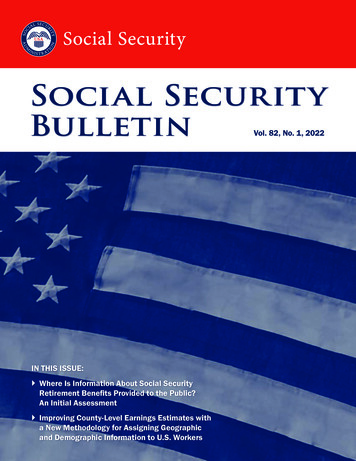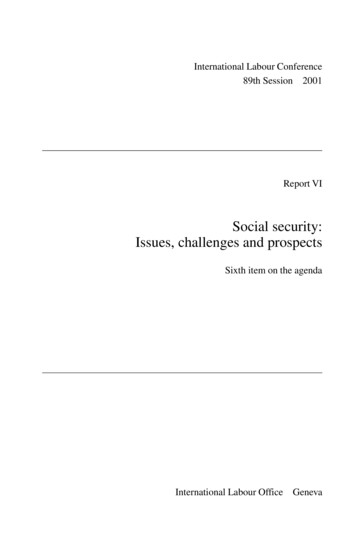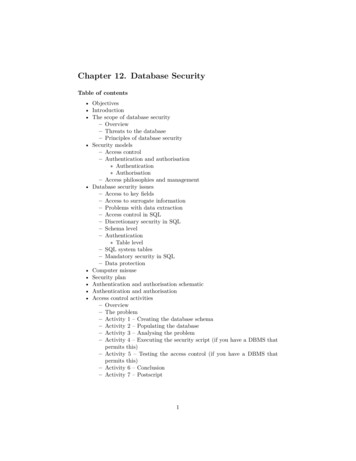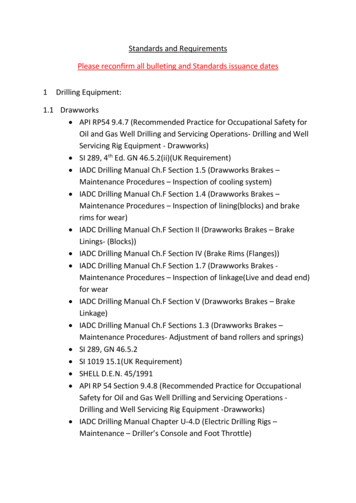
Transcription
Social SecuritySocial SecurityBulletinVol. 82, No. 1, 2022IN THIS ISSUE: Where Is Information About Social SecurityRetirement Benefits Provided to the Public?An Initial Assessment Improving County-Level Earnings Estimates witha New Methodology for Assigning Geographicand Demographic Information to U.S. Workers
The Social Security Bulletin (ISSN 19374666) is published quarterly by the SocialSecurity Administration, 250 E Street SW,8th Floor, Washington, DC 20254.The Bulletin is prepared in the Office ofRetirement and Disability Policy, Officeof Research, Evaluation, and Statistics.Suggestions or comments concerning theBulletin should be sent to the Office ofResearch, Evaluation, and Statistics at theabove address. Comments may also besent by e-mail to ssb@ssa.gov.Note: Contents of this publication are notcopyrighted; any items may be reprinted,but citation of the Social Security Bulletinas the source is requested. The Bulletinis available on the web at https://www.ssa .gov/policy/docs/ssb/.Errata Policy: If errors that impair datainterpretation are found after publication,corrections will be posted as errata onthe web at https://www.ssa.gov/policy /docs /ssb/v82n1/index.html.The findings and conclusions presented inthe Bulletin are those of the authors anddo not necessarily represent the views ofthe Social Security Administration.SSA Publication No. 13-11700Produced and published at U.S. taxpayer expenseKilolo KijakaziActing Commissioner of Social SecurityStephen EvangelistaActing Deputy Commissionerfor Retirement and Disability PolicyNatalie T. LuActing Associate Commissionerfor Research, Evaluation, and StatisticsOffice of DisseminationMargaret F. Jones, DirectorStaffJessie Ann DalrympleBenjamin PitkinWanda SivakPerspectives EditorMichael Leonesio
Social Security BulletinVolume 82 Number 1 2022Articles1Where Is Information About Social Security Retirement Benefits Provided to the Public?An Initial Assessmentby Lois A. Vitt and Barbara A. SmithResearch has documented how knowledgeable Americans are about certain aspects of SocialSecurity programs and benefits. As a result, researchers have identified information gaps in boththe types of knowledge that individuals optimally should have and the demographic groups whowould most benefit from informational outreach. However, research has not investigated thesettings in which Social Security information is or could be provided to the public by sourcesother than the Social Security Administration. This article explores the presence and extent ofSocial Security information provided to employees in workplaces, servicemembers in militaryfacilities, students in secondary and postsecondary schools, and participants in religious andcommunity organization settings. The authors visited seminars and classes; interviewed trainersand educators; and reviewed textbooks, other publications, and Internet content to assess wherethis important information is—or could be—provided to the public.11Improving County-Level Earnings Estimates with a New Methodology for AssigningGeographic and Demographic Information to U.S. Workersby Michael CompsonThis article describes a new methodology developed by the Office of Research, Evaluation, andStatistics (ORES) of the Social Security Administration (SSA) to indicate the state and countyof residence, date of birth, and sex of nearly all workers for whom tax records provide earningsdata in a given year. Applying these geographic and demographic indicators will enable ORESto use a vastly larger sample of workers to generate annual earnings estimates. The currentmethodology assigns state and county codes and demographic information only to workers inSSA’s 1-percent Continuous Work History Sample—fewer than 1.7 workers million in 2017.The new methodology would assign state and county codes and demographic informationto more than 178 million workers for 2017. A much larger sample of workers mitigates thelimitations associated with the current estimation process and enables ORES to generate morecomprehensive and accurate county-level earnings estimates.Social Security Bulletin, Vol. 82, No. 1, 2022iii
Where Is Information About Social SecurityRetirement Benefits Provided to the Public?An Initial Assessmentby Lois A. Vitt and Barbara A. Smith*Research has documented how knowledgeable Americans are about certain aspects of Social Security programsand benefits. As a result, researchers have identified information gaps in both the types of knowledge that individuals optimally should have and the demographic groups who would most benefit from informational outreach.However, research has not investigated the settings in which Social Security information is or could be provided tothe public by sources other than the Social Security Administration. This article explores the presence and extentof Social Security information provided to employees in workplaces, servicemembers in military facilities, studentsin secondary and postsecondary schools, and participants in religious and community organization settings. Wevisited seminars and classes; interviewed trainers and educators; and reviewed textbooks, other publications, andInternet content to assess where this important information is—or could be—provided to the public.IntroductionResearch has documented that Americans know basicaspects of Social Security, such as the existence of theretirement and disability programs, but they know little about the future benefits they can expect to receivefrom those programs (Greenwald and others 2010;Smith and Couch 2014; Yoong, Rabinovich, and Wah2015; Alattar and others 2019). For example, Alattarand others, using data from the University of SouthernCalifornia’s Understanding America Study, foundthat 80 percent of respondents know about the SocialSecurity Disability Insurance program. However,only 21 percent of respondents can correctly answer amultiple-choice question about the way Social Securitybenefits are calculated, and only 63 percent are awarethat a widow(er) need not be caring for children toqualify for survivor benefits. These studies also showthat knowledge about Social Security benefits is lowacross most demographic groups, whether categorizedby race, sex, income, or education. The one exceptionis age: Knowledge of Social Security increases withrespondent age. In 2020, the Social Security Administration (SSA) commissioned a survey by Ipsos PublicAffairs to measure the effectiveness of the Social Security Statement in informing the public about the SocialSecurity programs and benefits. The Ipsos surveyfound, for example, that respondents aged 62–69 aremore knowledgeable than those aged 25–34 about theadjustment of Social Security benefits for inflation(60 percent versus 22 percent) and the existence ofsurvivor benefits (78 percent versus 38 percent).Could the gaps in Social Security knowledge berelated to the settings in which information aboutretirement benefits is provided—or not provided?Selected AbbreviationsDODHRSSATSPDepartment of Defensehuman resourcesSocial Security AdministrationThrift Savings Plan* Lois A. Vitt is the director of the Institute for Socio-Financial Studies. When this research was conducted, she was on a temporaryprocurement with the Office of Research of the Office of Research, Evaluation, and Statistics (ORES), Social Security Administration(SSA) under the Intergovernmental Personnel Act mobility program and Barbara A. Smith, now retired, was a senior economist withORES, SSA.Note: Contents of this publication are not copyrighted; any items may be reprinted, but citation of the Social Security Bulletin as thesource is requested. The Bulletin is available on the web at https://www.ssa.gov/policy/docs/ssb/. The findings and conclusions presentedin the Bulletin are those of the authors and do not necessarily represent the views of the Social Security Administration.Social Security Bulletin, Vol. 82, No. 1, 20221
The low levels of knowledge about benefits amongyoung people suggest that providing Social Securityinformation to students in high schools, colleges,and universities could close some of the gaps. Thelack of knowledge about benefits regardless of sex orrace suggests that an overlapping variety of providerssuch as cultural- and minority-support organizations,religious institutions, and military trainers should beemployed to provide Social Security information tomost segments of society. The low levels of knowledgeacross income groups suggests that the workplacecan be a primary venue for providing information onSocial Security, especially because benefits are tied toemployment and earnings.highlights our findings and discusses the implicationsof where we found Social Security information currently being provided. The fourth section concludes,with a brief discussion about possible next steps.A brief review of the literature indicates thatresearchers have not widely studied the question ofwhere and how information about Social Securityretirement benefits is presently provided. Little isknown about which organizations provide informationabout Social Security, what specific kinds of information they provide, and to whom it is provided. Thisarticle explores how information about Social Securityretirement benefits is disseminated, who providesthat information, and where it is made available. Webelieve that identifying organizations that do or couldprovide information on Social Security might be ofinterest to SSA. The agency could use our findingsto develop effective collaborations for disseminatinginformation about Social Security as it creates outreach strategies involving pamphlets, videos, socialmedia posts, blogs, online applications, and newspaperand magazine articles.Our research took place primarily in 2015. Weconducted literature searches and other informationalreviews, analyzed online and print materials, observedclasses and courses (both in person and online), andspoke with sponsors and educators to identify themethods used to inform participants about SocialSecurity programs and benefits. We also reviewedwebsites featuring Social Security information andbenefit calculators, a sample of textbooks on personalfinance, and similarly themed books published in thepopular press.Of course, the primary source of information aboutSocial Security programs and benefits is SSA itself.The agency provides this information through its website, www.ssa.gov; through personal my Social Securityaccounts, for which individuals can sign up at https://www.ssa.gov/myaccount/; and through annual mailingsof printed Social Security Statements to individualsaged 60 or older who are not receiving benefits andhave not signed up for a my Social Security account.However, SSA is not the only source of informationabout Social Security. In addition to obtaining financialadvice from family and friends, individuals can acquireinformation from public, private, or nonprofit providersin various settings. People can also seek informationfrom financial advisors, online trading platforms,social media, television, books, and periodicals.This article consists of four sections beginning withthis introduction. The next section briefly describesour research methods and limitations. The third section2Research Methods and LimitationsWe conducted a qualitative study to identify, document, and assess where, when, and how informationabout Social Security’s programs and benefits is provided by employers, the military, religious institutions,secondary and postsecondary schools, and communityorganizations. We selected these providers based onextensive prior research that surveyed the state ofpersonal financial education offerings nationwide.1More specifically, we collected information using acombination of the following: Discussions with thought leaders, program sponsors, policymakers, financial service vendors,and educators who have broad knowledge of thefinancial-education content of programs offered inthe settings under study. Attendance at a purposive sample of seminars,courses, webinars, and workshops aboutSocial Security. Informal talks with participants at the seminars,courses, and workshops and, in some cases, areview of a sample of evaluations submittedby attendees. Assessment of Social Security–related literature,materials, and practices from academic, commercial, and popular sources disseminated via broadcast media, the Internet, and in print.Our qualitative review provides illustrative examplesof how and where Social Security information isprovided or not provided, but it is not meant to bedefinitive or exhaustive. Rather, it indicates the typesof information provided. The thought leaders andeducators with whom we spoke conduct or sponsorhttps://www.ssa.gov/policy/docs/ssb/
their personal finance training sessions in majorcities, small towns, and rural areas. We also talkedto individuals with direct knowledge of the financialeducation programs provided by large and smallorganizations that include financial institutions, multi national corporations, universities, military servicebranches, a nonprofit employee-benefit research group,and a labor union. The webinars, seminars, classes,and other meetings we attended are few in number butdiverse in terms of geographic location, program type,and the ages and interests of their attendees.2 Althoughthe research for this study was conducted primarily in2015, we have updated the information where possible.Note that the individuals who provided informationabout Social Security to their clients, students, orattendees hold divergent opinions about the longevityor viability of the Social Security program, which mayhave inadvertently skewed the findings we report.Security is included in employer-sponsored financialwellness programs, the topic is usually focused narrowly on the timing of claiming retirement benefits.Findings: Where and WhatInformation About Social SecurityIs Provided to the PublicAlthough we recognize the importance ofemployer-sponsored retirement saving plans, manyAmerican workers have little or no access to suchplans (Bureau of Labor Statistics 2021) and will likelyrely more heavily on, and need to understand, theirSocial Security retirement benefits. As a consequenceof the unmet need, many workers base critical SocialSecurity claiming decisions on limited information(Consumer Financial Protection Bureau 2015).In this section, we highlight the settings where theinformation about Social Security benefits is, orcould be, provided.WorkplacesAmericans typically are introduced to Social Security through the Federal Insurance Contributions Act(FICA) payroll-tax deductions from their paychecks.Thus, workplaces are appropriate venues for providing information about Social Security to workingAmericans. For example, information about SocialSecurity could be offered along with information aboutemployer-provided retirement plans.We found, however, that Social Security is notaddressed in most of the workplace financial educationprograms we investigated. In the 1990s, as employersponsored financial education became increasinglyavailable to employees, programs emphasized a “threelegged stool” metaphor for retirement security, with thelegs consisting of employer-sponsored pension plans,personal savings, and Social Security (DeWitt 1996).However, from recent discussions with the chief executive of a major employee-benefit research organization,human resources (HR) managers, financial educators,and retirement-benefit consultants, we learned that thatapproach began to disappear in the mid-2000s and thatnow, Social Security education is missing entirely fromnearly all workplace financial education programs.Further, we found that when information about SocialSocial Security Bulletin, Vol. 82, No. 1, 2022From the 1990s through the 2000s, employersincreasingly discontinued offering defined benefit pensions in favor of 401(k) and other defined contributionretirement plans. As 401(k) plans grew in numbers andimportance, company-sponsored education programsoften focused exclusively on their plan offerings andignored Social Security entirely. This trend coincidedwith the emergence of retirement plan vendors ratherthan the company’s HR department as the most likelyproviders of the saving and investment guidance offeredto a company’s employees. In a June–July 2015 survey,for example, only 16 percent of consumers reportedthat a current or former employer had been a source ofinformation about Social Security retirement benefits(Perron 2015).Fortunately, employers appear to have begun morerecently to again offer Social Security information totheir employees. As a result, benefits consultants andfinancial advisors hoping to be retained by employersto provide employee education have greater incentivesto include Social Security claiming advice, tools, andcalculators in their educational offerings. In particular,training providers may refer participants to onlineretirement-planning resources available from government, proprietary, or independent organizations.3However, claiming advice alone is insufficient; workers should be apprised of the purposes, importance,and breadth of Social Security benefits.A broader trend of employers providing information about Social Security benefits in the workplacewould give workers the knowledge they need tomake informed decisions about their future retirement benefits and their financial needs in general.However, our research indicates that few employersprovide comprehensive information and suggests thatemployers and retirement plan providers should addinformation about Social Security to the materialthey present to employees about company retirementplans. This information should include details about3
Social Security benefits, including eligibility requirements; benefit calculations; delayed claiming effects;and disability, dependent, and survivor benefit availability. Providers could also enhance their presentations by directing participants to the Department ofLabor’s “Retirement Toolkit” and SSA’s “RetirementChecklist.” 4 Employers, plan sponsors, or third-partyfinancial educators could show workers how to sign upnot only for the company’s retirement plan(s) but alsofor an online my Social Security account. Employersreport their workers’ earnings to SSA each year. Bychecking a my Social Security account or a SocialSecurity Statement received by mail, workers canensure that their earnings are correctly reported.Military FacilitiesThe U.S. armed forces have a long record of providingfinancial education to servicemembers. Prompted inpart by congressional hearings, the army establishedpersonal financial management programs in the mid1960s. Informal personal finance education for navypersonnel began in the early 1970s in wives’ clubsand ombudsman training programs. The navy starteda formal program in 1979 and the air force initiated asimilar program in the early 1980s. The navy revisedits formal program in the 1990s and the marine corpslikewise revised a prior formal program. UnderDepartment of Defense (DOD) leadership, all servicebranches consistently reappraise, upgrade, and supportpersonal financial management education and counseling programs (Vitt 2010).Since 1950, servicemembers have contributed toand been covered by Social Security. The servicebranches provide personal finance training, required byDOD regulation and policy, to servicemembers duringboot camp and at intervals throughout their militarycareers until they leave active service. Servicemembersaged 30 or younger constitute nearly three-quarters ofactive-duty personnel. The average ages for enlistedpersonnel and officers are 26.9 and 34.4, respectively(DOD 2019, Exhibits 2.41 and 2.45). Given the agerange of most servicemembers and their families, theprograms concentrate on the financial needs of youngerindividuals, covering topics such as credit cards, borrowing, buying a car, payday loans, deciding whetherto rent or buy a home, and postservice career choices.5Social Security is addressed only briefly.In all workplace settings but especially for youngmilitary servicemembers, Social Security topics covered in training should include the number of creditsneeded for benefit eligibility, how benefit levels are4calculated, and the importance of retirement savingto complement Social Security benefits. The trainingshould also correct a common misconception that aspouse will receive 50 percent of the primary earner’sbenefit in virtually all cases; the actual percentage willdepend on the spouse’s earnings history and claiming age. Financial educators and counselors must beknowledgeable about the circumstances and life eventsthat affect Social Security income in retirement and beable to discuss the many intricacies involved in longterm Social Security planning.Social Security information should become astandard component of the personal finance education provided during boot camps. As part of thattraining, educators could avail themselves of SSAinformation that is targeted to younger audiences,such as the “Retirement Ready Fact Sheet for WorkersAges 18–48” (https://www.ssa.gov/myaccount/assets /materials/workers-18-48.pdf).6To learn more about the ways the armed forcescould provide information about Social Security,we attended a meeting of the Financial EducationRoundtable of Hampton Roads, comprising militaryfinancial educators and counselors in greater Norfolk,Virginia—home to approximately 83,000 active dutypersonnel in all service branches—and participatedin a discussion about the role of Social Security inservicemembers’ financial futures.We learned that roundtable educators did notaddress Social Security in personal finance classes andcounseling sessions, and that they knew little about theprogram themselves. Interest in learning about SocialSecurity was strong among roundtable educators, especially among those approaching retirement age. By theend of our 2-hour discussion, educators acknowledgedthat Social Security education was needed for allservicemembers regardless of age. Yet a subsequentfollow-up with our roundtable contacts disclosed thatkey Social Security issues and concepts are still offeredin very few money-management classes for servicemembers or training courses for financial educators,with the possible exception of information providedwhen a servicemember transitions from the armedservices into civilian life, from active to reserve components, or, especially, into retirement. Each of thesetransition training sessions provides military educatorswith a timely opportunity to increase servicemembers’knowledge of Social Security programs and benefits.Results of the 2020 Ipsos survey commissionedby SSA show that age is closely linked to knowledge about Social Security.7 For example, 60 percenthttps://www.ssa.gov/policy/docs/ssb/
of respondents aged 62–69 know that benefits areadjusted for inflation while only 22 percent of thoseaged 25–34 do. Seventy-eight percent of the oldergroup know that Social Security provides survivorbenefits compared with 38 percent of the youngergroup. This split suggests that many younger individuals might also not be aware of other important information about Social Security, such as the earningsrequirements for benefit eligibility and the relationshipbetween earnings and benefit calculations.Because our investigation indicates that informationon Social Security is not widely offered to militaryservicemembers at present, we infer that DOD couldplay a much more important role in informing itsyoung personnel. The army implemented a mandatory8-hour financial education course for new soldiers in2007–2008. After the sessions, which included information on the Thrift Savings Plan (TSP—the government equivalent of a 401(k) plan), TSP participationincreased by 125 percent and contributions increasedby 115 percent among program attendees (Skimmyhorn 2016). Such behavioral response to informationabout the TSP suggests that providing informationabout Social Security would similarly increase soldiers’ knowledge about the benefits they could expectfrom the program.Religious InstitutionsOur research found that financial education programssponsored by religious groups generally fall into oneof two categories. The first is developed specificallyfor members of a particular denomination. Thesecourses are offered within the congregational community and often align with a denominational message.The second includes efforts that are sponsored, initiated, or developed by the religious organization for thebenefit of the greater community, generally to assistparticular groups by offering a variety of financialskills training or identifying where and how to findpotential financial resources.Thrivent Financial, a Lutheran nonprofit membershiporganization, is an example of the first type of program.Thrivent provides insurance products and services forits member-owners as a fraternal organization underthe lodge system, which means a member belongs to alocal chapter of the larger society. Thrivent’s purposeis “to help people achieve financial clarity, enablinglives full of meaning and gratitude” (Thrivent 2020).It provides financial planning, which includes courseson investing and government programs. Thrivent alsoprovides seminars on Social Security and retirement.Social Security Bulletin, Vol. 82, No. 1, 2022We attended two seminars led by a Social Securityexpert who addressed groups of 30–35 attendees, mostof whom appeared to be preretirees.An example of the second type of program is provided by the Unity church, which also sponsors classeson Social Security for groups of church members,mostly preretirees. Unlike the Thrivent program,however, the Unity church ministry independentlydetermines that a need exists in its congregation (forexample, for a course on Social Security) and theninvites members of the greater community to attend.Other religious organizations making a similar determination have turned to community-based programs,or Internet offerings such as the “Benefits Checkup”sponsored by the National Council on Aging, to provide needed information.A 2020 Gallup poll shows that religious identification is strongly correlated with age (Jones 2021).For example, 66 percent of respondents born before1945 report that they are members of a congregation,compared with 58 percent of baby boomers (born1946–1964), 50 percent of generation X (born 1965–1979), and 36 percent of millennials (born 1980–2000).These results suggest that religious organizations mightbe particularly effective in reaching adults aged 40 orolder with information on Social Security. Religiousgroups could thereby fill a gap for individuals whodo not receive such information from their employers. This avenue has a significant limitation, however:These sessions are usually organized only when aparticular need is identified by one or more membersand when potential attendees already know the personwho would conduct the program.High SchoolsWe investigated secondary school–level personalfinance curricula and found little available informationthat might interest students in, or prepare them for,understanding the Social Security program. However,one encouraging exception might foretell a change.At a Washington, DC, charter school, a social studies teacher of 11th graders instructed the students toresearch Social Security reform. Teams of studentstook turns over several days presenting their researchon the funding needs and the policies that will likelyaffect their future Social Security income (and perhaps that of their parents). The students advocated forpolicy initiatives to sustain Social Security benefits,having become aware during their research of theirparents’ and grandparents’ experienced or anticipatedreliance on the retirement program.5
We also reviewed personal-finance textbooks usedin high school (and college) courses. Among those wechose was Foundations of Personal Finance, EighthEdition (Campbell 2010). We selected this textbookbecause it aligns with national standards, developed bythe Jump tart Coalition for Personal Financial Literacy, “to ensure that high-school graduates have theknowledge necessary to become financially responsible adults.”individuals with less education are also less likely towork in jobs that offer retirement plans, less likelyto have the resources to save on their own, and morelikely to rely on Social Security benefits for theirretirement income. Information about Social Securityretirement benefits must therefore be provided to thembefore they leave high school.Social Security is introduced in the Campbell textbook under “Federal Government Spending” as the“largest entitlement program” funded by payroll taxes.In a later section headlined “Paying Social SecurityTaxes,” the topic is expanded with brief descriptionsof Social Security retirement, disability, and survivorbenefits. No social or financial history is cited, nor arethe societal purposes for which the programs exist.The “story” of Social Security is omitted along withany account of its accomplishments over more than7 decades. Social Security plays a lifelong role inany young person’s saving habits and future financialwell-being. We believe young people would be wellserved if they were provided with details about SocialSecurity—its history and societal context as well asits benefits.We found personal finance courses that include information about Social Security programs and benefitsoffered in business schools and as electives in other2- and 4-year institutions. Social Security informationis also taught to students who specialize in HR management or related fields. Apart from those who havecareer or business interests in such topics, though,college students have little opportunity to be taughtabout Social Security.One book providing an informative discussion ofSocial Security programs and benefits is A YoungPerson’s Guide to Social Security (Edwards, Turne
benefit calculators, a sample of textbooks on personal finance, and similarly themed books published in the popular press. More specifically, we collected information using a combination of the following: Discussions with thought leaders, program spon-sors, policymakers, financial servi











